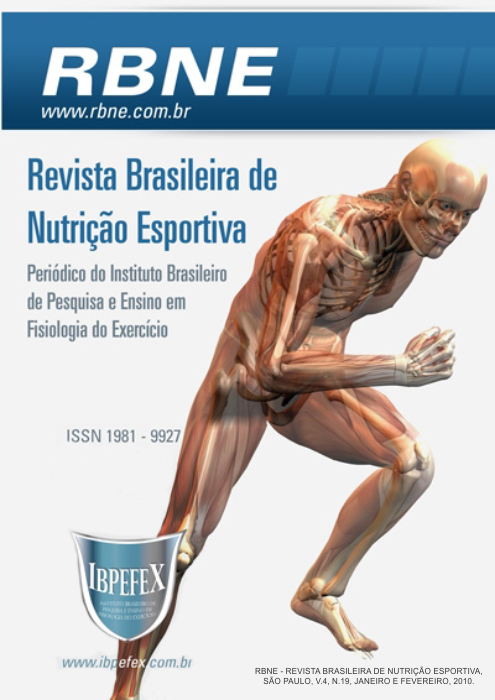Analysis of levels of water loss and percentage of sweat rate in competitive swimmers from São Caetano do Sul-SP
Abstract
Swimming modifies the relationship of body thermogenesis, thereby influencing hydration. Hydration is essential for good athletic performance and the percentage of water loss and sweat rate are efficient methods to assess the state of hydration. The objective was to analyze and compare the water loss and sweat rate of swimmers in São Caetano do Sul. The sample consisted of 14 athletes of both genders, aged 15 to 20 years. They trained 2 hours a day, five times a week. The athletes were weighed before and after practice to calculate the rate of sweating and water loss. Information about the type and amount of ingested fluid were taken from each athlete. These data were collected in a single day. Of the sample, 57.14% drank water, took 35.72% carbohydrate solution and 7.14% is not hydrated. The average sweat rate in hydration with water was 5.8 ml/min and hydration with maltodextrina was 5.7 ml/min. All finished the training well hydrated Immersion lose heat faster than on land, causing the stimulus for the sweating is low. However, dehydration can occur, the main risk to theathletes in the heat, requiring replacement of water losses. It follows that even the sweat rate of the swimmers to be low compared to other sports, this should be considered toavoid dehydration, because it is progressive and cumulative.
References
-Barbieri, P.B.N.; Adeodato, M.M.; Souza, M.M.; Zanuto, R. Análise da Composição Corporal de Atletas de Natação da Categoria Infantil do Sexo Masculino. Revista Brasileira de Nutrição Esportiva. São Paulo. Vol. 1, Num. 2, 2007. p.1-11.
-Costill, D.; Wilmore, J.H. Fisiologia do Esporte e do Exercício. 1.ed. São Paulo: Manole, p. 708, 2001.
-Ferreira, F.G.; AlmeidaG.L.; Marins, J.C.B. Efeitos da ingestão de diferentes soluções hidratantes nos níveis de hidratação e na freqüência cardíaca durante um exercício de natação intervalado. Revista Portuguesa de Ciências do Desporto. Porto. Vol. 7. Num. 3. 2007. p. 319-327.
-Guerra, I. Importância da alimentação e da hidratação do atleta. Revista Mineira de Educação Física. Viçosa. V. 12. Num. 2. 2004. p. 159-173.
-Henkin, S.D. Respostas de sudorese de nadadores, corredores e indivíduos não treinados após exercício no calor.Dissertação de Mestrado. Universidade Federal do Rio Grandedo Sul, Porto Alegre, 2007.
-Luft, C.D.B.; Krug, M.R. Efeitos da ingestão de bebidas isoenergéticas durante o treinamento de natação. Revista de Educação Física. Maringá. Vol. 14. Num 2. 2003. p.33 –39.
-Marins, J.C.B.; Dantas, E.H.M.; Navarro, S.Z. Diferentes tipos de hidratação durante o exercício prolongado e sua influência sobre o sódio plasmático. Revista Brasileira de Ciência e Movimento. Brasília. Vol. 11. Num. 1. 2003. p. 13-22.
-Maughan, R.J.; Burke, L. M. Nutrição esportiva: Manual de Ciência e Medicina Esportiva. Artmed, p.190, 2004.
-Moreira, C. A. M.; Gomes, A. C. V; Garcia, E. S.; Rodrigues, L. O. C. Hidratação durante o exercício: a sede é suficiente? Revista Brasileira de Medicina do Esporte. Niterói. Vol.12. Num. 6. 2006. p. 405 –409.
-Prado, E.S.; Barroso, S.S.; Góis, H.O.; Reinert, T. Estado de Hidratação em Nadadores após Três Diferentes Formas de Reposição Hídrica na Cidade de Aracaju –SE. Fitness & Performancé Journal. Rio de Janeiro. Vol. 8. Num. 3. 2009. p. 218-225.
-Saat, M.; Sirisinghe, R.G.; Singh, R., Tochihara, Y. Effects of short-term exercise in the heat on thermoregulation, blood parameters, sweat secretion and sweat composition of tropic-dwelling subjects. Journal of Physiological Anthropology and Applied Human Science. New Jersey. Vol. 24. Num. 5. 2005. p. 541-549.
-Shirraffs, S.M. The importance of good hydration for work exercise performance. Nutrition Reviews. Laussane. Vol. 63. Num. 3. 2005. p.14-21.
-Tavares, R.G.; Bassuíno, M.; Puffal, J.; Vicenzi, F.; Schmidt, G.; Deotti, J.; Coitinho, A. S. Importância da reposição hídrica em atletas: aspectos fisiológicos e nutricionais. Revista Digital. Buenos Aires. Vol.13. Num. 119. 2008.
Authors who publish in this journal agree to the following terms:
- Authors retain the copyright and grant the journal the right of first publication, with work simultaneously licensed under the Creative Commons Attribution License BY-NC which allows the sharing of the work with acknowledgment of the authorship of the work and initial publication in this journal.
- Authors are authorized to enter into additional contracts separately for non-exclusive distribution of the version of the work published in this journal (eg, publishing in institutional repository or book chapter), with acknowledgment of authorship and initial publication in this journal.
- Authors are allowed and encouraged to post and distribute their work online (eg, in institutional repositories or on their personal page) at any point before or during the editorial process, as this can bring about productive change as well as increase impact and impact. citation of published work (See The Effect of Free Access).






